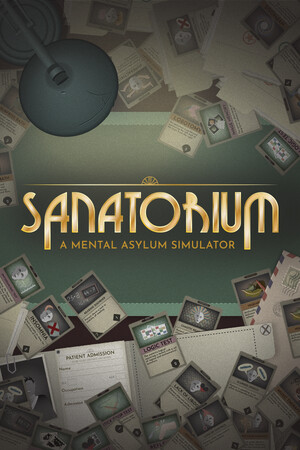Sanatorium – A Mental Asylum Simulator - Lags, stuttering issues and low FPS - fix it!

Sanatorium – A Mental Asylum Simulator – Fix Lags, Stuttering and Low FPS
Experiencing lags, stuttering, low FPS, or delays in Sanatorium – A Mental Asylum Simulator? These issues can ruin the fun and make gameplay frustrating. Luckily, there are several ways to improve performance and make Sanatorium – A Mental Asylum Simulator run smoother. Follow the steps below and enjoy a better gaming experience.
Why Sanatorium – A Mental Asylum Simulator Might Lag or Stutter
Poor optimization, outdated drivers, background programs, or incorrect settings can all lead to performance problems. Sometimes the cause is the game’s code itself, but in many cases, you can fix it with the right tweaks. If nothing works, check if other players are reporting similar problems, for example on the Sanatorium – A Mental Asylum Simulator Steam community forum.
1. Download the Latest Update or Patch
Make sure you have the most recent version of Sanatorium – A Mental Asylum Simulator. Game updates often contain bug fixes and optimizations. On Steam, updates install automatically when you launch the game. If you own a physical copy or standalone installer, visit the publisher’s or developer’s website to download the latest patch.
2. Update Your Drivers
Outdated drivers, especially for your graphics card, can cause lags, stuttering, and FPS drops. Always keep your drivers up to date to ensure compatibility with the latest game technologies.
If you don’t know how to update them manually, use a trusted tool that will scan your PC and automatically install the latest versions.
Click here to see our recommended program for automatic driver installation.
3. Adjust Graphics Settings
Lowering graphics quality can dramatically improve performance in Sanatorium – A Mental Asylum Simulator. Even if your PC meets the recommended specs, poor optimization can still cause issues. Try reducing settings like shadows, anti-aliasing, and texture quality to gain more FPS.
4. Set the Game to High Priority
This tells your operating system to allocate more CPU resources to Sanatorium – A Mental Asylum Simulator, which can help improve performance.
- Open Sanatorium – A Mental Asylum Simulator.
- While in-game, press CTRL + SHIFT + ESC to open Task Manager.
- Go to the Details tab and find the game’s main process.
- Right-click it, go to Set Priority, and select High.
- Restart the game and check if FPS improves.
5. Disable the Steam Overlay
The Steam overlay uses CPU, GPU, and RAM, which can slightly reduce FPS. Disabling it may improve performance.
- Open Steam and go to Library.
- Right-click Sanatorium – A Mental Asylum Simulator and choose Properties.
- In the General tab, uncheck Enable Steam Overlay while in-game.
- Restart the game and check your FPS.
6. Clean Up Your PC
Remove unused programs, free up disk space, and scan for viruses. Too many background processes can lower performance. Also, clean your PC physically — dust buildup can cause overheating, which reduces your CPU and GPU efficiency.
Conclusion
By following these steps, you can fix lags, stuttering, and low FPS in Sanatorium – A Mental Asylum Simulator. Small changes often bring big improvements, so test different combinations until you find what works best for your system.

Frequently Asked Questions (FAQ)
Why is Sanatorium – A Mental Asylum Simulator running slowly or lagging?
Performance drops can be caused by high graphics settings, insufficient hardware resources, outdated drivers, or too many background applications. Lowering graphics quality, updating your GPU drivers, and closing unnecessary programs often helps improve performance.
What causes stuttering in Sanatorium – A Mental Asylum Simulator?
Stuttering can occur due to inconsistent frame rates, slow storage devices, outdated drivers, or insufficient RAM. Make sure your drivers are updated, consider moving the game to an SSD, and adjust in-game settings to maintain a stable FPS.
How do I fix low FPS in Sanatorium – A Mental Asylum Simulator?
Lower your graphics settings, reduce resolution, enable performance-boosting features like DLSS or FSR if supported, and ensure your drivers are up to date. Also, check for overheating issues that may cause your hardware to throttle performance.
Can my internet connection affect lag in Sanatorium – A Mental Asylum Simulator?
Yes, if the game has online features, a slow or unstable connection can cause network lag. Use a wired connection if possible, avoid streaming or downloading in the background, and restart your router to refresh the connection.
Does enabling V-Sync reduce stuttering in Sanatorium – A Mental Asylum Simulator?
V-Sync can help eliminate screen tearing, but it may introduce input lag or reduce FPS if your hardware cannot consistently match the refresh rate. You can also try adaptive sync options like G-Sync or FreeSync if your monitor supports them.
Why did performance in Sanatorium – A Mental Asylum Simulator drop after an update?
Sometimes new updates introduce bugs, higher system requirements, or compatibility issues. Check the game’s patch notes, update your drivers, and wait for hotfixes if the problem is widespread in the community.
